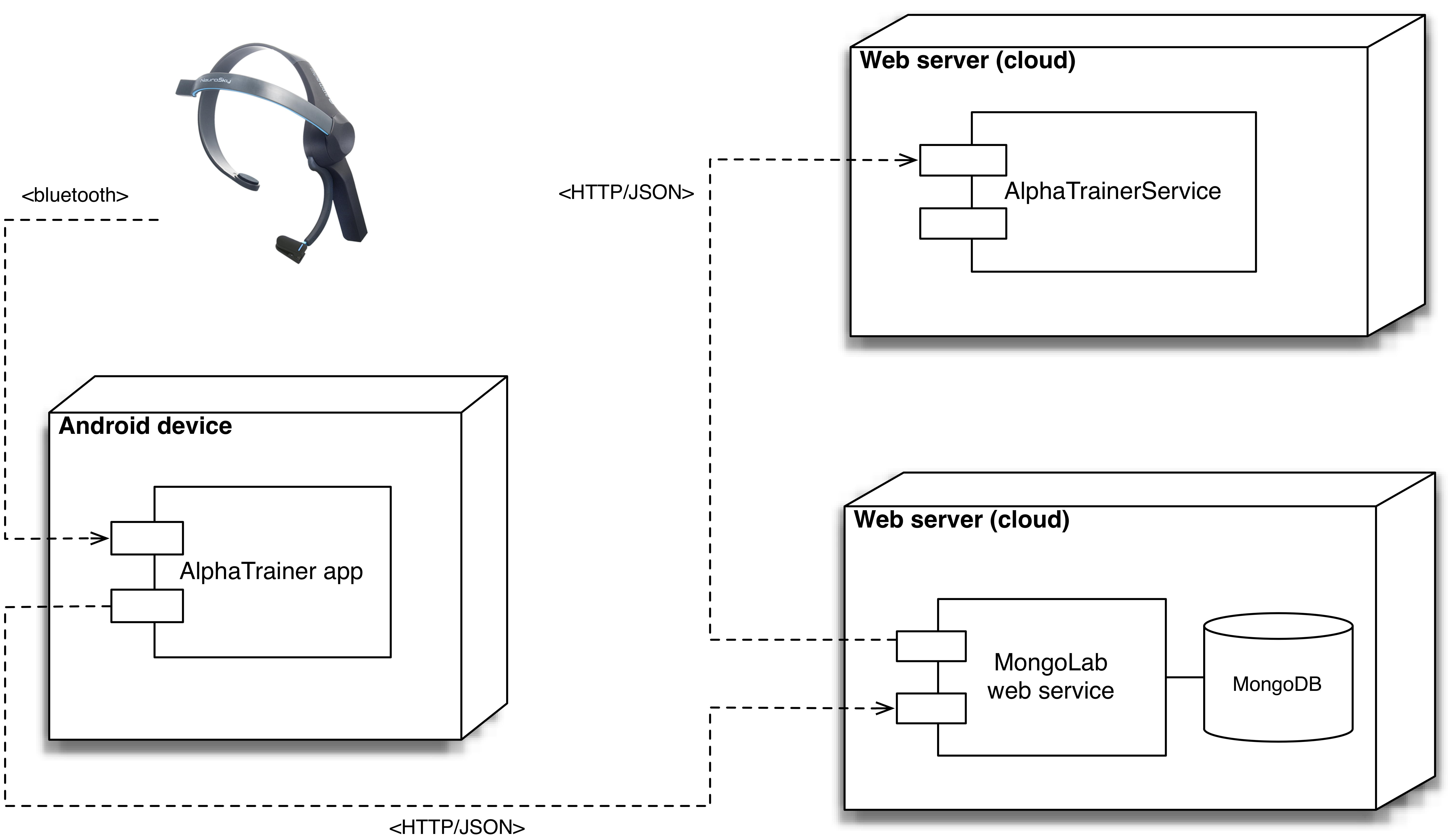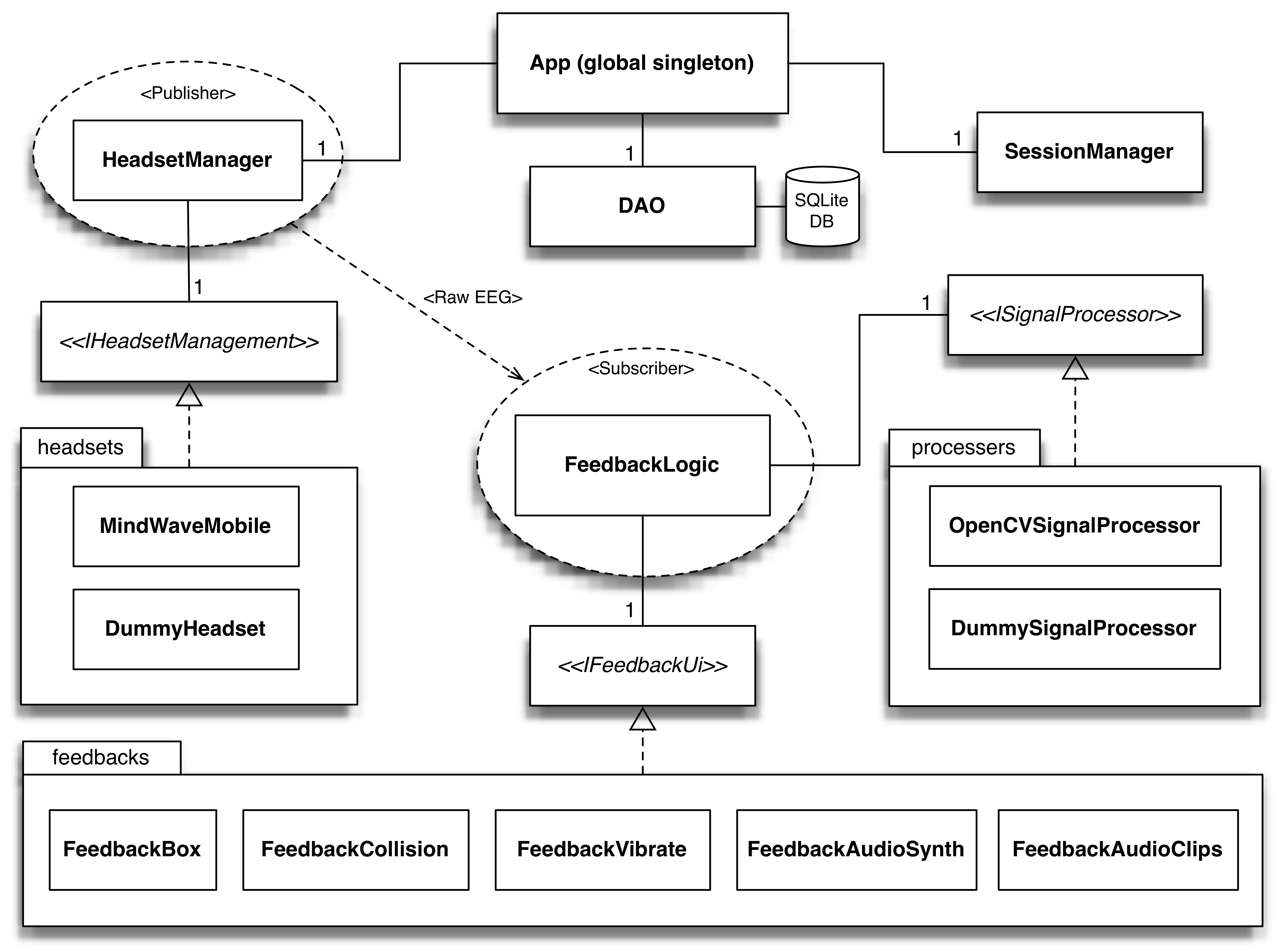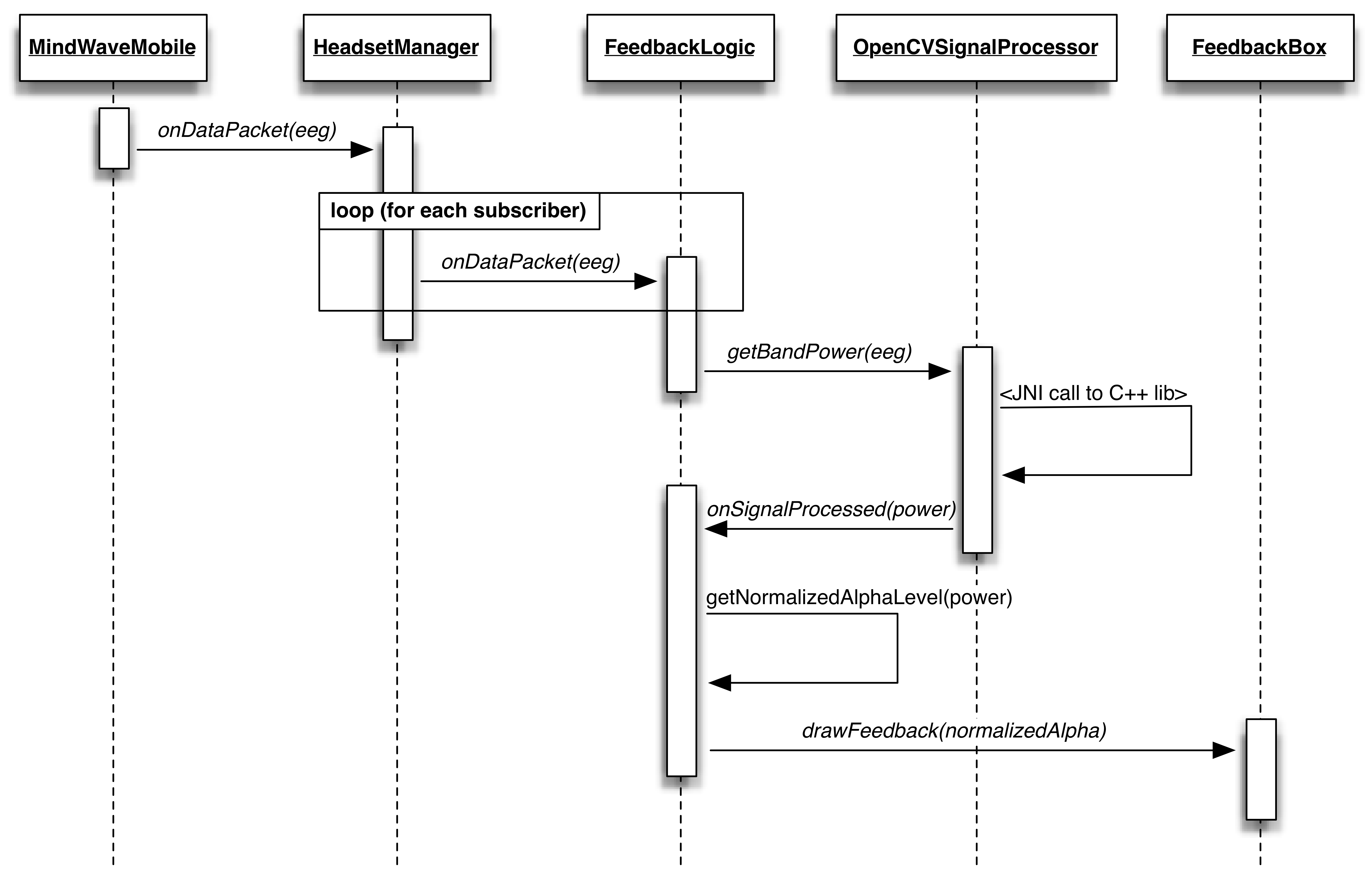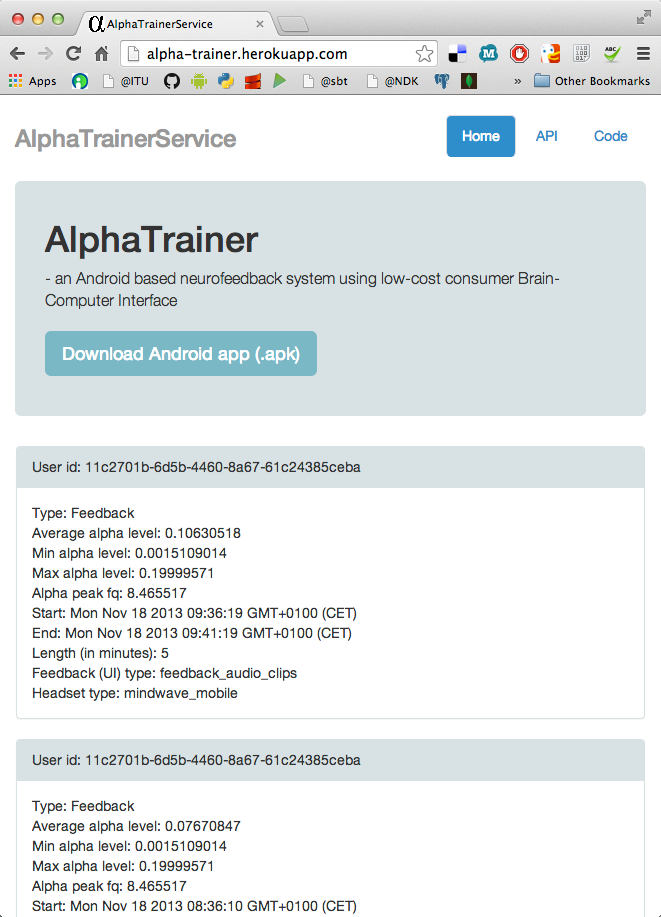5 Implementation¶
AlphaTrainer is a system composed of several components. This chapter presents each of their implementation. Figure 5.1 gives an overview of the different parts of AlphaTrainer and their relationship.
5.1 Signal processing library¶
Starting low level, we have implemented a small C++ library for processing raw EEG data (Appendix AlphaTrainer signal processing library). It is based on the open-source OpenCV 2 library 3.
OpenCV is primarily used for computer vision and contains methods for image analysis and processing. OpenCV 2 has been rewritten from C to C++ and is optimized to handle numerical data like vectors or matrices of float values [7]. This is exactly what we need when processing EEG data which at this level is represented as arrays of float values.
The implementation of this library is based on the signal processing and EEG data knowledge gained from the BCI Evaluation Chapter 3. The strategies, algorithms and data cleaning are roughly mirrored 1:1 in this library the main difference being that this library is intended for real-time usage.
Implementing the signal processing in C++ was chosen due to its performance advantages over Java in regard to numerical manipulation [55]. This may seem overkill for the current MindWave BCI configuration in which 512 data points are processed every second, but it secures scalability for future headsets presumably increasing sample rate and depth. For the same reason, we refrain from making the assumption that a headset carries only one channel by letting the library support multichannel EEG data 2.
The library can be called from the Java Virtual Machine (JVM) through the Java Native Interface (JNI) 4 [39].
Usage of the library is defined in the opencvbrainprocessor.h interface:
1 2 3 4 5 6 7 8 9 10 11 | #include "opencv2/core/core.hpp"
#include "signalprocessingutil.h"
#ifndef OPENCVBRAINPROCESSOR_H_
#define OPENCVBRAINPROCESSOR_H_
float getBrainProcessed(float eeg[], int channels, int samples, int Fs,
float lowCutFq, float highCutFq, float alphaPeak);
float getAlphaPeak(float eeg[], int channels, int samples, int Fs);
void getMinMax(float alphaLevels[], float* result, int alphaLevelsLength, int factor);
#endif /* OPENCVBRAINPROCESSOR_H_ */
|
This interface is implemented in opencvbrainprocessor.cpp. It contains three methods which in combination make up our signal processing. We now briefly explain the substance of each method.
The getRelativeAlphaLevel() method computes the relative alpha level taking raw EEG data and the alpha peak frequency as input. The procedure consists of: (i) applying FFT to the EEG data; (ii) then for each frequency bin of the FFT output, the value is squared (to go from amplitude to power); finally (iii) return the relative alpha level which is calculated by dividing the power of the alpha band (defined as 1 Hz to either side of the alpha peak frequency) with the power of the total band (defined as the band between the lowCutFq and highCutFq parameters). During the BCI evaluation we had good experiences with a low cut frequency of 5 Hz and a high cut frequency of 25 Hz (3.2.2). These values are currently used by AlphaTrainer.
The getAlphaPeak() method computes which frequency has the highest occurring amplitude within the alpha band (7 Hz - 13 Hz) taking raw EEG (recorded during calibration) as input. The procedure is this: (i) apply FFT to the EEG data; (ii) trim the resulting frequency domain down to the alpha band and; (iii) find the maximum amplitude and return the corresponding frequency.
Finally, the method getMinMax() computes how alpha levels should be mapped to feedback states. The resulting min and max values determine, for example, the thresholds for the Box feedbacks red and green states. It takes an array of relative alpha levels (from a baseline recording) as input. The procedure is to: (i) calculate mean and standard deviation of the input alpha levels; (ii) set min/max values to mean +/- the standard deviation multiplied with a factor (a method parameter); finally (iii) if min < 0 it is replaced by the lowest appearing value in the input data.
By design, this signal processing library is kept stateless. For example, it receives the alpha peak frequency and sample rate for every alpha level processing call. Keeping the processing module stateless simplifies the integration with the app by allowing a low coupling. This will be elaborated in the following section in which the library's user - the Android app - is explained.
5.2 Android app¶
Android is an open source operating system (OS) for mobile devices initiated by Google. Our rationales for choosing this platform includes that: (i) fits well for prototyping; (ii) has gained wide adoption; and (iii) has unrestricted deployment to end users through the Google Play store.
Android is a mature OS and is currently released in version 4.4. AlphaTrainer requires Android 3.0 (API level 9) or later 6.
An introduction to the Android programming model is out of scope - the interested reader is referred to the comprehensive official documentation 5. Instead, this section will focus on the overall architecture and the most important design patterns used in the AlphaTrainer Android app implementation.
5.2.1 Overview¶
An overview of the architecture is shown in Figure 5.2. The diagram is by no means exhaustive and the aim is to highlight the relationships between BCIs (headsets), data processing, feedback views, application state and persistent storage. This diagram will function as the reference throughout the presentation of the Android app in the succeeding sections.
A main architectural goal of the implementation is a modular design which enables replacement of the different components i.e. the headset, data processor or the feedback view. How modularity is achieved will emerge during the discussion of the individual components and their relations to other components.
5.2.2 State management¶
We take a singleton approach [14] to global app state management. The singleton is implemented in the App class which extends the Android framework Application. In short, the Android framework guarantees that exactly one instance of the class is loaded at all times throughout the lifetime of the application, which makes it safe to write a getInstance() method 1. Our application singleton is the center point for: (i) reading user preferences which takes place in the SessionManager; (ii) reading and writing from persistent storage which takes place in the data access object DAO; and (iii) managing headset connection which is takes place in HeadsetManager as well as in the singleton itself.
| [1] | http://developer.android.com/reference/android/app/Application.html |
5.2.3 Headset¶
To support future consumer BCIs such as the already announced Muse and Emotiv INSIGHT (see Section 2.2.4), we have put effort into being as headset agnostic as possible. Implementing the signal processing ourselves is one way of doing so since this allows us not to rely on the signal processing abilities of a specific BCIs SDK.
Another way to obtain headset agnosticism is by communicating with the specific BCIs through a thin interface thus abstracting from the specific BCIs API by wrapping it in an implementation of the <<IHeadsetManagement>> interface:
1 2 3 4 5 6 7 8 9 10 | package dk.itu.alphatrainer.interfaces;
public interface IHeadset {
public int getNrOfChannels();
public int getSampleRate();
public int getIcon();
}
public interface IHeadsetManagement extends IHeadset {
public void startDataStream();
public void stopDataStream();
}
|
Only the HeadsetManager uses the <<IHeadsetManagement>> interface. All other communication with the headset goes through the methods defined by <<IHeadset>> through which meta-data about the headset can be accessed.
AlphaTrainer currently contains two <<IHeadsetManagement>> implementations: DummyHeadset and MindWaveMobile - both in the dk.itu.alphatrainer.headset package. The DummyHeadset is used for development and testing and it outputs a random signal. The MindWaveMobile implements and uses the ThinkGear API 7 bundled with the MindWave Mobile headset (Section 2.2.2). Concrete communication with the MindWave headset goes through the TGDevice class. An example of the <<IHeadsetManagement>> interface implementation is shown below:
1 2 3 4 5 6 7 8 9 10 11 12 13 14 15 16 17 18 19 20 21 22 23 24 25 26 27 28 29 | package dk.itu.alphatrainer.headset;
...
import com.neurosky.thinkgear.TGDevice;
public class MindWaveMobile implements IHeadsetManagement {
private BluetoothAdapter bluetoothAdapter;
private TGDevice tgDevice;
...
public MindWaveMobile(IHeadsetListener listener) {
this.listener = listener;
}
...
@Override
public void startDataStream() {
...
bluetoothAdapter = BluetoothAdapter.getDefaultAdapter();
...
if (bluetoothAdapter != null) {
tgDevice = new TGDevice(bluetoothAdapter, handler);
}
...
tgDevice.connect(true);
...
}
@Override
public void stopDataStream() {
tgDevice.stop();
tgDevice.close();
}
...
|
Distribution of data from the headset is implemented in a publish subscribe pattern. In order to receive data from the headset, a class must implement the <<IHeadsetDataListener>> interface:
1 2 3 4 | package dk.itu.alphatrainer.interfaces;
public interface IHeadsetDataListener {
public void onDataPacket(int channels, float[][] data);
}
|
Whenever a headset receives data, it calls its <<IHeadsetListener>> with the data formatted in the form of an array of float arrays each representing an EEG channel. This will always be the HeadsetManager which is the only class implementing the <<IHeadsetListener>> interface which generalizes the <<IHeadsetDataListener>> and <<IHeadsetConnectionStatusListener>> interfaces. The HeadsetManager then distributes the data to each of its registered <<IHeadsetDataListener>> thus carrying out the publisher act. Below we see an example showing how the private class CalibrationDataHandler within ActivityCalibrate first registers itself for receiving EEG data (l. 7) and later calls the headset for meta-data (l. 8-9).
1 2 3 4 5 6 7 8 9 10 | package dk.itu.alphatrainer.calibration;
...
private class CalibrationDataHandler implements IHeadsetDataListener {
...
public CalibrationDataHandler(ActivityCalibrate parent) {
this.parent = parent;
App.getInstance().getHeadsetManager().subscribeData(this);
Fs = App.getInstance().getHeadsetManager().getHeadset().getSampleRate();
int numberOfChannels = App.getInstance().getHeadsetManager().getHeadset().getNrOfChannels();
...
|
The distribution of connection status updates is similarly implemented in a publish subscribe pattern using the <<IHeadsetConnectionStatusListener>> interface.
Since the headset can be changed by the user through a settings entry and we generally want the app to depend as little as possible on the concrete headset implementations, we have implemented the factory pattern. Specifically, the headsets are instantiated by the HeadsetFactory in the package dk.itu.alphatrainer.factories which is responsible for instantiating a concrete headset appropriate for the current headset settings entry.
5.2.4 Signal processing¶
The implementation of the signal processing takes the same approach as was taken with the headsets to achieve modularity. Again, the communication goes through a thin interface which allows for easy replacement of the signal processing module.
1 2 3 4 5 6 7 8 9 10 | package dk.itu.alphatrainer.interfaces;
import dk.itu.alphatrainer.model.AlphaMinMax;
public interface ISignalProcessor {
public void getBandPower(float[][] data, int Fs, float alphaPeak);
public float getAlphaPeak(float[][] data, int Fs);
public AlphaMinMax getMinMax(float[] alphaPowers);
}
public interface ISignalProcessingListener {
public void onSignalProcessed(float bandPower);
}
|
<<ISignalProcessor>> is currently implemented by DummySignalProcessor and OpenCVSignalProcessor found in the dk.itu.alphatrainer.signalprocessing package. The DummySignalProcessor is for development and testing, and it simply outputs dummy values. OpenCVSignalProcessor encapsulates the OpenCV based library described in Section 5.1. In the example below, important lines of OpenCVSignalProcessor are shown in which it receives its listener in the constructor and declares its usage of the C++ library (Section 5.1) through the native keyword:
1 2 3 4 5 6 7 8 9 10 11 | package dk.itu.alphatrainer.signalprocessing;
...
public class OpenCVSignalProcessor implements ISignalProcessor {
...
private ISignalProcessingListener listener;
public OpenCVSignalProcessor(ISignalProcessingListener listener) {
this.listener = listener;
}
...
public native float getRelativeAlphaLevel(float[] eeg, int samples, int Fs, float alphaPeak);
...
|
5.2.5 Data flow¶
This section describes the data flow and call hierarchy involved from the point where the BCI receives raw EEG data up till the point where the feedback view is called with a processed and normalized alpha level.
As can be seen in the app overview diagram Figure 5.2, the FeedbackLogic class connects the raw EEG data, the signal processing and the feedback UI. Figure 5.3 shows a flow diagram of the calls involved from raw EEG is received to the feedback UI is called. Notice how all calls between the classes are interface method calls and would be exactly the same for other combinations of headset, processor and feedback UI.
The diagram also shows our usage of the publish subscribe pattern in that the HeadsetManager distributes the received EEG data to all listeners registered for receiving data.
5.2.6 Feedback user interfaces¶
A feedback UI is generalized in a simple interface:
1 2 3 4 5 | package dk.itu.alphatrainer.interfaces;
public interface IFeedbackUi {
public void drawFeedback(int i);
public void stop();
}
|
The drawFeedback() method takes a normalized alpha level from 0 to 100 and transforms this number into a visible, auditive or tactile feedback to the user. We have currently implemented 5 different feedback UIs found in the dk.itu.alphatrainer.ui.feedback package - reference the Design Chapter 4 for a visual and conceptual explanation of each feedback Figure 4.5. The feedback package consists of:
- Box is implemented in the FeedbackBox class. It uses build-in Android animation features to make the transitions from red to green depending on the normalized alpha level.
- Circles is implemented in the FeedbackCollision class. It uses an Android WebView and the circles are based on the open-source visualization Javascript library d3.js 8. The WebView loads the Javascript and HTML/CSS from the Android specific assets folder within the AlphaTrainer Android app. On receiving a normalized alpha level, FeedbackCollision dispatches it to the WebView which handles the feedback actuation in a Javascript method.
- Vibration is implemented in the FeedbackVibrate class and utilizes the Android system service architecture through which the vibration of the phone can be accessed.
- Tone is implemented in the FeedbackAudioSynth class. It uses the build in Android audio library in conjunction with pure Java to crate a small synthesizer.
- Bells is implemented in the FeedbackAudioClips class. It uses another build in Android audio library able to load and play sound clips from files.
Similar to the headsets, the feedbacks can be changed by the user through a setting. For the same reason, we also use the factory pattern to instantiate a concrete feedback UI class. This responsibility is delegated to the FeedbackUiFactory which read the user setting and instantiate the appropriate feedback.
5.2.7 Models and persistent storage¶
We have benefited of the built in SQLite 9 database within the Android framework. All training data such as alpha peak frequencies and the relative alpha levels are timestamped and persistently stored in the SQLite database from where they can be queried with SQL 10. The raw EEG data is currently stored in plain text files on the mobile device's SD card.
All concrete database communication takes place in the DAO class from the dk.itu.alphatrainer.datastorage package. This encapsulation represents another typical design-pattern with Java and Android [64].
We have modeled a training and a processed alpha level respectively as Recording and AlphaLevel classes within the dk.itu.alphatrainer.model package. Below a snippet from the AlphaLevel class:
1 2 3 4 5 6 7 8 9 10 11 12 13 14 15 16 17 18 19 20 21 22 23 24 25 26 27 28 29 30 | package dk.itu.alphatrainer.model;
...
import com.google.gson.annotations.Expose;
import com.google.gson.annotations.SerializedName;
...
public class AlphaLevel {
@Expose
@SerializedName("alpha_level")
private float alphaLevel;
@Expose
@SerializedName("normalized_alpha_level")
private int normalizedAlphaLevel;
@Expose
@SerializedName("time_stamp")
private long timeStamp;
public AlphaLevel(float alphaLevel, int normalizedAlphaLevel, long timeStamp) {
this.alphaLevel = alphaLevel;
this.normalizedAlphaLevel = normalizedAlphaLevel;
this.timeStamp = timeStamp;
}
public float getAlphaLevel() {
return alphaLevel;
}
public int getNormalizedAlphaLevel() {
return normalizedAlphaLevel;
}
public long getTimeStamp() {
return timeStamp;
}
}
|
Some fields of the AlphaLevel class are annotated with @Expose and @SerializedName. This is part of the Gson library 11 which we use to serialize the models to JavaScript objects (JSON) 12. With the annotations we can control which fields of the class should be serialized and how the naming should be. We post the JSON serialized training data to a cloud based web service over HTTP, which is elaborated below in Section 5.3). The JSON training object has this structure:
{
"user_id" : "9cc6e095-4efa-4cc2-85ff-c792b34e40f5" ,
"type" : "Baseline" ,
"alpha_levels" : [
{
"time_stamp" : 1382695986 ,
"normalized_alpha_level" : 6 ,
"alpha_level" : 0.016940186
},
...
] ,
"headset_type" : "mindwave_mobile" ,
"feedback_ui_type" : "feedback_audio_clips" ,
"average_alpha_level" : 0.07930513 ,
"time_stamp_start" : 1382695986 ,
"time_stamp_end" : 1382696286 ,
"length" : 300 ,
"max_alpha_level" : 0.15 ,
"min_alpha_level" : 0.008 ,
"alpha_peak_fq" : 9.362069
}
The user_id is in an id anonymously generated client side (in the Android app) using the UUID class from the standard Java library. Generating and storing the id client side ensures that the web service cannot know who the user behind the id is.
The actual post to the cloud based storage is handled in a non-blocking asynchronous task - the PostRecordingToServiceTask class in the dk.itu.alphatrainer.cloud package - which is called when a feedback or baseline recording is finished. If the recording is not successfully posted to the service (which is identified by the absence of a returned row-number from the service), this will be attempted again later.
5.3 Cloud based storage¶
The AlphaTrainer system currently relies on a cloud based NoSQL database to store training data from its users (Appendix Mongolab cloud storage). We currently use the open-source MongoDB 13 database hosted in the cloud as a service by MongoLab 14 - but MongoDB can in principle be installed anywhere. MongoDB is a document based database opposed to a traditional relational database like SQLite which we use within the AlphaTrainer Android app (Section 5.2.7). MongoDB stores data, for example a training session including an array of alpha levels, as documents grouped into collections - the documents are very similar to JSON objects [49].
This database storage choice for the current AlphaTrainer system is founded in the software as a service (SaaS) concept - "... SaaS delivers software and data as a service over the internet ..." [25]. Advantages of the cloud based MongoDB at MongoLab include that we can access it: (i) through command line and do queries directly in the database; (ii) through a specific language dependent driver for example for Java; finally (iii) MongoLab exposes an RESTful web service API out of the box offering Create, Read, Update and Delete (CRUD) operations [20]. This cloud service component of the AlphaTrainer system enables the AlphaTrainer Android app to upload training data which can be consumed by the AlphaTrainerService Client explained below in Section 5.3.1 and any future clients with the need for accessing the data - for example a client created for usage by a clinical professional.
At last we show our usage of one of the features MongoDB offers, namely the ability to map reduce large data set - the map reduce concept is taken from functional programming [2]. The following example shows how all the average alpha level per user interface can be queried from all recordings in the training dataset through map reduction:
1 2 3 4 5 6 7 8 9 10 11 12 13 14 | var mapFeedbackUIAvgAlpha = function() {
emit(this.feedback_ui_type, this.average_alpha_level);
};
var reduceAvgAlpha = function(feedbackUIType, averageAlphaLevel) {
return Array.avg(averageAlphaLevel);
};
function showFeedbackUITypeAvgAlphaLevelAvg() {
db.trainings.mapReduce(
mapFeedbackUIAvgAlpha,
reduceAvgAlpha,
{ out: "feedback_ui_alpha_average" });
return db.feedback_ui_alpha_average.find();
}
showFeedbackUITypeAvgAlphaLevelAvg();
|
First the function maps all the feedback user interfaces and average alpha levels from all the trainings and then reduce it by averaging the items created in the map step. This procedure produces the following JSON response:
{ "_id" : "feedback_box", "value" : 0.09779977771875001 } // Box
{ "_id" : "feedback_collision", "value" : 0.09649314506956522 } // Circles
{ "_id" : "feedback_vibrate", "value" : 0.14137012283529413 } // Vibrate
{ "_id" : "feedback_audio_clips", "value" : 0.0934931038888889 } // Bells
{ "_id" : "feedback_audio_synth", "value" : 0.11333089719230771 } // Tone
This in an example of a query which would be really interesting to run when AlphaTrainer (hopefully) has been used by many people over a long period of time. We return to this perspective in the Future works Section 7.1.
5.3.1 AlphaTrainserService Client¶
We have created a simple webapp client - AlphaTrainserService which can consume the cloud based storage at MongoLab (Appendix AlphaTrainerService client). At the moment this webapp simply allows viewing the recorded data grouped by (anonymous) users and their training sessions, see Figure 5.4.
The AlphaTrainserService webapp is implemented with the Play Framework 15 which is written in Scala 16 - a functional programming language built on top of Java [28]. The webapp uses the the Bootstrap front-end framework 17 for the user interface combined with BackBone.js 18 - a MVC based JavaScript framework. Bootstrap is highly flexible and met our simple UI requirements out of the box. BackBone.js is used to continuously pull in new training recordings without reloading the webpage [48].
The AlphaTrainserService Client is currently deployed to Heroku 19 - a SaaS hosting environment built on top of the Amazon AWS infrastructure 20.
JSON and RESTful web service are first citizen concepts within the Play Framework. This means AlphaTrainserService could also expose a web service if, for example, the AlphaTrainer system should encounter requirements which can not be meet by the MongoLab web service. Additionally, the Play Framework can be used to build type-safe and a highly scalable web services as well.
With this cloud based client and data storage in hand we have a solid, flexible and highly scalable storage as an important infra structure underneath the AlphaTrainer Android application.
5.4 Summary¶
In this chapter, we have explained the central concepts of the implementation of AlphaTrainer. Most importantly, several design patterns have been applied to ensure a modular architecture of the Android app. This enables easy support for future headsets and new feedback views as well as replacement of the signal processing. The modularity ensures that the contribution of implementing the AlphaTrainer system still has value even if it should become apparent, for example, that the current state of BCIs are not good enough for performing neurofeedback.
Through the explanation of the Android app, only few Android specific components were mentioned. The same is true for the app overview diagram in Figure 5.2 which has no dependencies on Android. This carries the point that we have separated the logic as much as possible from the Android specific components. This makes it easy to port the application to, for example, iOS even though it will have to be rewritten in Objective C for the iOS environment. The concepts are the same and the native signal processing library can even be compiled to and called from iOS as well. The cloud based storage is of course agnostic in regard to the OS of its clients as long as they speak HTTP.
The scalable cloud based approach to data storage and the simple webapp consuming this data makes the proof of concept that the AlphaTrainer system could easily be integrated in, for example, a clinical context - in which case a client for the clinician would have to be designed and build for this purpose. This would raise some solvable security issues deemed out of scope for this AlphaTrainer system prototype.
Footnotes
| [2] | Multichannel EEG would require small adjustments in regard to the communicating with the library. |
| [3] | http://opencv.org |
| [4] | http://docs.oracle.com/javase/7/docs/technotes/guides/jni. |
| [5] | http://developer.android.com/ |
| [6] | Main parts of the AlphaTrainer Android App work even from version 2.3 (API level 9) and up except of the Circle feedback covered within Section 5.2.6 which relies on browsers that implement Scalable Vector Graphics (SVG). |
| [7] | http://developer.neurosky.com/docs/doku.php?id=thinkgear_connector_tgc |
| [8] | d3.js is written in Javascript and it heavily relies on SVG - http://d3js.org |
| [9] | http://www.sqlite.org/ |
| [10] | http://en.wikipedia.org/wiki/SQL |
| [11] | https://code.google.com/p/google-gson |
| [12] | http://json.org |
| [13] | http://www.mongodb.org |
| [14] | https://mongolab.com |
| [15] | http://www.playframework.com |
| [16] | http://www.scala-lang.org |
| [17] | http://getbootstrap.com |
| [18] | http://backbonejs.org |
| [19] | https://www.heroku.com |
| [20] | http://aws.amazon.com |



